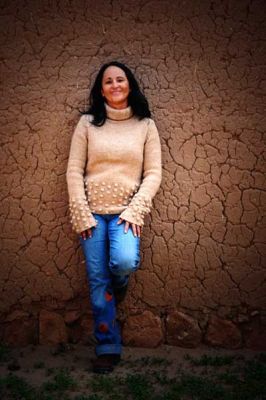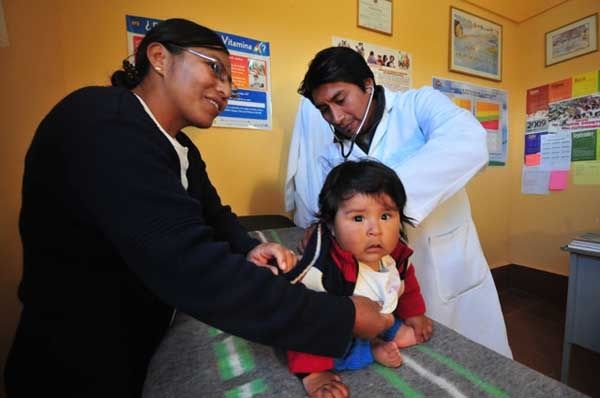Born into Bolivia
photo documentary by Terry Sebastian, text by Erin Tandy
A unique pilot project by Uniterra bridges the gap between traditional and conventional medicine, allowing doctors and midwives to work together to help mothers and infants. For a full description of the project, click here>>
Produced with the support of the Government of Canada through the Canadian International Development Agency.
-
b2 b2
One of the main goals of the project is to bridge the divide between practitioners of conventional and traditional medicine. Andean nutritionist Isabel Quispe Cutili displays a few of the more than 200 plants that have been used for healing in Bolivia for centuries.

-
b3 b3
One of the first intercultural birthing rooms in Bolivia is put to good use as Teodora Aquino Choque and her baby are reunited. Not only are the cozy rooms built to look like home instead of a hospital, they also feature all the amenities of home, like kitchens and space for family.

-
b1 b1
Since Montreal-native Miriam Rouleau-Perez spearheaded the project in 2006, several Canadian volunteers have continued with her work. Midwives Teodora Aquino Choque from Bolivia and Sandra Demontigny from Canada discuss a recent successful birth.

-
b4 b4
The name of the pilot project translates to "An Aguayo for risk-free childbirth: Action for mothers and newborns." The aguayo, shown here in use by a future mother, is a traditional hand-woven garment used by Andeans to carry babies, food and belongings.

-
b5 b5
Ruth Bolaños, a Bolivian woman who took over as chief of the project in June 2009, stands in front of the new birthing rooms in Belen de Andamarca. Bolaños attests to the difference the project has made: "[Before the project] 74 percent of expecting women gave birth in their homes, with only their ill-equipped husbands attending to any complications." Less than a year after the project began, 84 percent of women chose to deliver at the local health centre, and participation is continuing to grow.

-
b6 b6
While the project has afforded Bolivian midwives greater respect, tension still exists between traditional and conventional medicine practitioners. A doctor and nurse perform a check-up in Belen hospital, which was funded by PASS Canada.

-
b7 b7
The project has also led to midwives being employed by the Bolivian government for the first time. Gregoria Calle was the first and has played a huge role in the project's success – her status in the community greatly encouraged participation. In a birthing room in Curahuara de Carangas, she prepares a newborn to meet her mother.

-
b8 b8
While women traditionally dominate the business of birth, these local men in Belen are doing their part for the project by constructing the birthing rooms. They are using traditional building methods for their work, which can be seen behind them.

-
B9 B9
Two new birthing rooms have been constructed in Belen that will serve a large indigenous community. They are located close to a hospital that already attracts people from other communities, some walking for hours to receive care there.

-
b10 b10
The Andean region of Bolivia is steeped in tradition and the main source of income is production of llama and alpaca wool. Respect for this traditional way of life is a key ingredient in the success of "An Aguayo for risk-free childbirth: Action for mothers and newborns."

One of the main goals of the project is to bridge the divide between practitioners of conventional and traditional medicine. Andean nutritionist Isabel Quispe Cutili displays a few of the more than 200 plants that have been used for healing in Bolivia for centuries.
One of the first intercultural birthing rooms in Bolivia is put to good use as Teodora Aquino Choque and her baby are reunited. Not only are the cozy rooms built to look like home instead of a hospital, they also feature all the amenities of home, like kitchens and space for family.
Since Montreal-native Miriam Rouleau-Perez spearheaded the project in 2006, several Canadian volunteers have continued with her work. Midwives Teodora Aquino Choque from Bolivia and Sandra Demontigny from Canada discuss a recent successful birth.
The name of the pilot project translates to "An Aguayo for risk-free childbirth: Action for mothers and newborns." The aguayo, shown here in use by a future mother, is a traditional hand-woven garment used by Andeans to carry babies, food and belongings.
Ruth Bolaños, a Bolivian woman who took over as chief of the project in June 2009, stands in front of the new birthing rooms in Belen de Andamarca. Bolaños attests to the difference the project has made: "[Before the project] 74 percent of expecting women gave birth in their homes, with only their ill-equipped husbands attending to any complications." Less than a year after the project began, 84 percent of women chose to deliver at the local health centre, and participation is continuing to grow.
While the project has afforded Bolivian midwives greater respect, tension still exists between traditional and conventional medicine practitioners. A doctor and nurse perform a check-up in Belen hospital, which was funded by PASS Canada.
The project has also led to midwives being employed by the Bolivian government for the first time. Gregoria Calle was the first and has played a huge role in the project's success – her status in the community greatly encouraged participation. In a birthing room in Curahuara de Carangas, she prepares a newborn to meet her mother.
While women traditionally dominate the business of birth, these local men in Belen are doing their part for the project by constructing the birthing rooms. They are using traditional building methods for their work, which can be seen behind them.
Two new birthing rooms have been constructed in Belen that will serve a large indigenous community. They are located close to a hospital that already attracts people from other communities, some walking for hours to receive care there.
The Andean region of Bolivia is steeped in tradition and the main source of income is production of llama and alpaca wool. Respect for this traditional way of life is a key ingredient in the success of "An Aguayo for risk-free childbirth: Action for mothers and newborns."









